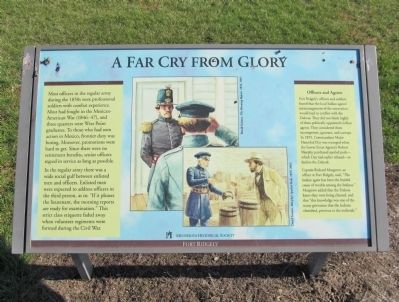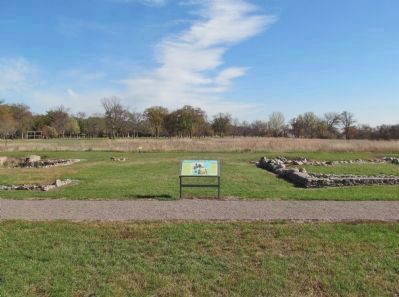Near Fairfax in Nicollet County, Minnesota — The American Midwest (Upper Plains)
A Far Cry from Glory
Most officers in the regular army during the 1850s were professional soldiers with combat experience. Most had fought in the Mexican-American War (1846-47), and three quarters were West Point graduates. To those who had seen action in Mexico, frontier duty was boring. Moreover, promotions were hard to get. Since there were no retirement benefits, senior officers stayed in service as long as possible.
In the regular army there was a wide social gulf between enlisted men and officers. Enlisted men were expected to address officers in the third person, as in: "If it pleases the lieutenant, the morning reports are ready for examination." This strict class etiquette faded away when volunteer regiments were formed during the Civil War.
Fort Ridgely's officers and soldiers feared that the local Indian agents' mismanagement of the reservation would lead to conflict with the Dakota. They did not think highly of these politically appointed civilian agents. They considered them incompetent, ignorant, and corrupt. In 1855, Commandant Major Hannibal Day was outraged when the Lower Sioux Agency's Robert Murphy purchased spoiled pork—which Day had earlier refused—to feed to the Dakota.
Captain Richard Musgrove, an officer at Fort Ridgely, said, "The Indian agent has been the fruitful cause of trouble among the Indians." Musgrove added that the Dakota knew they were being cheated, and that "this knowledge was one of the many grievances that the Indians cherished, previous to the outbreak."
Fort Ridgely
Erected by the Minnesota Historical Society.
Topics and series. This historical marker is listed in these topic lists: Forts and Castles • Native Americans. In addition, it is included in the Minnesota Historical Society series list. A significant historical year for this entry is 1855.
Location. 44° 27.165′ N, 94° 44.038′ W. Marker is near Fairfax, Minnesota, in Nicollet County. Marker can be reached from County Highway 30, 1.1 miles State Highway 4, on the right when traveling west. Monument is in Fort Ridgely State Park; fee area – a Minnesota state park vehicle permit is required. Touch for map. Marker is at or near this postal address: 72404 County State Aid Highway 30, Fairfax MN 55332, United States of America. Touch for directions.
Other nearby markers. At least 8 other markers are within walking distance of this marker. Officers' Quarters—A (a few steps from this marker); Officers' Quarters—B (a few steps from this marker); Officers' Latrines (a few steps from this marker); Fort Ridgely State Monument (within
shouting distance of this marker); Five Days and Nights on the River (within shouting distance of this marker); A Doctor's Life (within shouting distance of this marker); Garrison Life Was Like Clockwork (within shouting distance of this marker); Surgeon's Quarters—Headquarters (within shouting distance of this marker). Touch for a list and map of all markers in Fairfax.
More about this marker. captions:
• David Geister, The Morning Report, 1856, 2005
• David Geister, Murphy's Spoiled Pork, 1855, 2005
Also see . . .
1. Military Etiquette. Reprinted work from Notes on Military Etiquette by Richard S. Joslyn. (Submitted on February 15, 2014.)
2. Autobiography of Capt. Richard W. Musgrove. Page 162; The Massacre of 1862. "...many of the traders among these Indians, aware that a treaty was probable, sold at exorbitant prices a large amount of goods to these people on credit, or made up large fictitious claims." (Submitted on February 15, 2014.)
3. U.S.-Dakota War of 1862. David Geister paintings. (Submitted on February 15, 2014.)
Credits. This page was last revised on June 16, 2016. It was originally submitted on February 15, 2014, by Keith L of Wisconsin Rapids, Wisconsin. This page has been viewed 569 times since then and 16 times this year. Photos: 1, 2. submitted on February 15, 2014, by Keith L of Wisconsin Rapids, Wisconsin.

